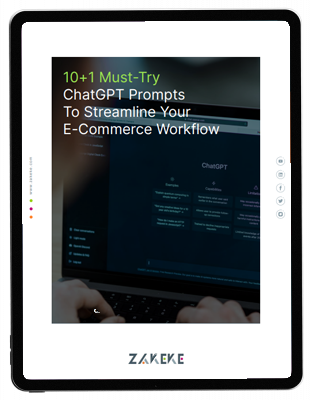Although many regard the shopping cart as just a place to hold items before purchase, nothing can be further from the truth. A shopping cart in e-commerce is a critical component that can make or break a sale.
A well-designed and optimized cart significantly boosts conversion rates, increases average order values, and enhances customer satisfaction. However, a poorly executed cart strategy often leads to high abandonment rates and lost revenue.
In this article, we’ll explore essential strategies for creating an effective e-commerce cart that maximizes sales and ensures a seamless e-commerce customer experience for your shoppers. From user-friendly design and personalization to security measures, you will have the tools to turn your online shopping cart into a powerful revenue stream.
Causes and impact of shopping cart abandonment on your e-commerce business
Before we start exploring how you can improve your shopping cart, it’s essential to understand what causes customers to abandon their carts.
Unexpected costs
When shoppers proceed to checkout and encounter additional fees, such as high shipping charges, taxes, or handling fees, they tend to feel surprised or even deceived. This often leads to an immediate decision to abandon the cart, as the final price exceeds their expectations.
Complex checkout process
A complex or lengthy checkout process causes frustration and leads to customers abandoning their carts before completing a purchase. If the checkout involves too many steps, requires unnecessary information, or doesn’t provide a guest checkout option, customers may lose patience and take their business elsewhere.
Lack of trust and security concerns
Security concerns are one of the main factors why people abandon their online shopping carts. If your e-commerce site lacks trust signals, such as SSL certificates, recognizable payment options, and security badges, customers may fear for the safety of their personal and financial information. This lack of trust usually results in cart abandonment, especially among first-time visitors.
In 2023, approximately 70% of online shopping carts were abandoned, highlighting a significant loss of potential revenue. These missed chances are significant because they represent the inability to turn customer interest into real transactions, reducing the return on investment (ROI) from marketing campaigns designed to draw these potential buyers to the site.
Shopping cart optimization strategies that drive sales
Now is the time to discuss how you can overcome the aforementioned issues and skyrocket your sales.
Focus on usability
A clear and intuitive layout allows customers to easily navigate the checkout process. Clear product information and easy-to-use features for adding, editing, and removing items minimize confusion and help customers make confident buying choices.
Additionally, making the shopping cart accessible from any page on the website is essential for a seamless user experience. Placing cart icons prominently in the navigation ensures that users can easily review and adjust their picks at any time. This accessibility makes it easier for customers to make impulse purchases and helps guide them toward making a purchase, which in turn increases sales and improves customer satisfaction overall.
Encourage customers to complete purchases
Implementing exit-intent popups, which offer discounts or reminders as customers attempt to leave the website, serves as a powerful tool to re-engage potential buyers. These popups encourage customers to rethink their choice to leave without finalizing their purchase, using incentives to increase sales.
Sending abandoned cart email reminders with personalized messages and incentives is another effective strategy. These emails remind customers of the items left in their cart and can include special offers or discounts. By personalizing the message and incentivizing a return to complete the purchase, you can recover potentially lost sales and strengthen customer loyalty.
Furthermore, having a persistent cart function that stores products for customers who leave and return later makes shopping easier and motivates them to complete their purchases. This feature ensures that customers can easily resume their shopping without losing their selected items. This reduces friction in the buying process and increases the likelihood of conversion.
Offer multiple payment options
Allowing customers to choose from various methods like credit cards, PayPal, Apple Pay, and Google Wallet caters to diverse preferences, and reduces payment barriers that frequently lead to cart abandonment.
This approach aligns with global digital payment trends. For instance, in 2023, mobile wallets accounted for half of all e-commerce transactions worldwide and are projected to grow at a 14.9% CAGR from 2023 to 2027. Integrating these popular payment methods into the checkout process enables you to capitalize on this trend and meet evolving customer expectations.
Moreover, providing a guest checkout option simplifies the buying process by allowing customers to complete purchases without creating an account.
To further expand payment options and attract a wider audience, consider integrating cryptocurrency as a payment method. By enabling customers to use their crypto portfolios for purchases, you can tap into the growing cryptocurrency market and position your business as a forward-thinking brand.
Provide transparent pricing
Showing customers all the costs upfront, including product prices, shipping fees, taxes, and any extra charges, helps them know exactly how much they’ll be spending right from the start. This transparency helps in managing customer expectations and avoids potential surprises during checkout.
Including a shipping calculator directly on the cart page further improves transparency. This tool allows customers to estimate shipping costs based on their location and chosen shipping method before proceeding to checkout.
Enhance the mobile shopping experience
Optimizing the shopping cart and checkout process specifically for mobile devices ensures that users can easily navigate, browse, and complete purchases on their smartphones or tablets. Responsive design plays a pivotal role in this, adapting the layout and functionality seamlessly across different screen sizes.
As of May 2024, mobile devices accounted for the majority of visitors to e-commerce sites, comprising 73% of total traffic. This further proves the significance of catering to mobile users with a user-friendly experience.
Implement personalized recommendations
Besides creating a more engaging shopping experience, personalized product recommendations also contribute to increased conversion rates and revenue generation.
Leverage artificial intelligence (AI)
Utilize AI and machine learning technology to examine user actions, like browsing habits, buying trends, and likes, in order to recommend suitable items right in the shopping cart. By suggesting items that closely match the customer’s interests, this tactic enhances the likelihood of additional purchases.
Increase average order value (AOV)
You should also integrate cross-selling and upselling opportunities into the shopping cart. Cross-selling suggests complementary products that enhance the main purchase, while upselling encourages customers to consider higher-end alternatives or additional features. Both aim to increase AOV and customer lifetime value by enticing customers with relevant and appealing options.
Lastly, displaying recently viewed or trending items within the cart reinforces product discovery and visibility, which encourages impulse buys. By showcasing such items, you can capitalize on customers’ current interests.
Leverage real-time inventory updates
By displaying live inventory information on product pages and in the shopping cart, you can motivate your customers to make quicker purchasing decisions. Additionally, notifying shoppers when an item is low in stock helps to maintain customer interest. The alerts notify them of decreasing availability, urging them to finalize their purchase before the product is completely sold out.
Moreover, notifying customers when an out-of-stock item becomes available again, keeps them engaged and leads to increased sales upon the item’s return.
Offer a wishlist or save options
Providing save or wishlist options allows customers to save items they are interested in but may not be ready to purchase immediately. This convenience encourages them to return to the site later, increasing the chances of a future sale. Wishlists also serve as a reminder tool for customers, helping them keep track of products they want to buy.
Additionally, you can use data from wishlists to gain insights into customer preferences and popular products. You can use this information for targeted marketing campaigns, Facebook ads optimization, ecommerce SEO, and personalized recommendations, ultimately boosting sales.
Enhance security and build trust
When it comes to completing purchases online, trust is everything. Implementing SSL certificates is crucial, as it encrypts data and ensures secure transactions. This encryption reassures customers that their sensitive information, such as credit card details, is protected during the checkout process.
Displaying security badges and trust seals prominently on the cart and checkout pages also plays a vital role in building customer confidence. Visible indicators of security measures help to assure customers that your site is safe and trustworthy, which reduces cart abandonment.
Additionally, regularly updating and auditing security measures to protect customer data and prevent fraud is essential. Continuously monitoring and improving your security protocols helps safeguard against potential threats, instilling confidence in your customers and encouraging them to complete their purchases without hesitation.
Conclusion
Having an effective e-commerce cart strategy in place is crucial for maximizing sales and providing a seamless shopping experience for your customers. Understanding and addressing the causes of shopping cart abandonment, such as unexpected costs, a complex checkout process, and security concerns, are essential first steps toward improvement.
Implementing usability improvements ensures a user-friendly cart with intuitive navigation, while e-commerce cart strategies like exit-intent popups, abandoned cart emails, and persistent carts encourage customers to complete their purchases. Offering multiple payment options, providing transparent pricing, and enhancing the mobile shopping experience further reduce barriers to purchase and increase conversions.
Personalized recommendations, real-time inventory updates, and wishlists help engage customers and increase AOVs. Finally, robust security measures build trust and encourage customers to finalize their transactions confidently.
By incorporating these strategies into your e-commerce platform, you can turn your shopping cart into a powerful asset for increasing sales and improving customer satisfaction.















